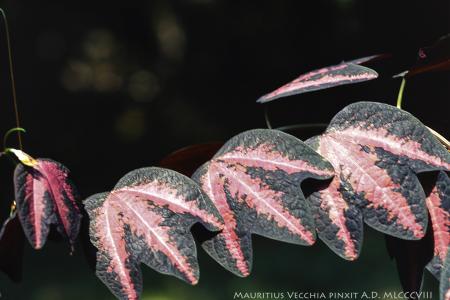
SUBGENUS: decaloba
SUPERSECTION: decaloba
SECTION: decaloba
GEOGRAPHICAL DISTRIBUTION OR ORIGIN:
Amazon regions of Peru.
MINIMUM TEMPERATURE: 5 °C
IDEAL MINIMUM TEMPERATURE: 8 °C
ETYMOLOGY: From the Latin tri-, three and fasciatus with bands: for the leaves characterized by three longitudinal coloured bands.
DESCRIPTION:
Among the many passionflowers with coloured leaves that I know of is the extraordinary P. trifasciata. I was able to see it grow from seed and was fascinated to observe the continuous changes in shape and colour of the leaves: at first, they are green with timid ash spots but later become covered with three intense pink bands lying against a dark green, almost bronze background. Over time, the pink fades to yellow and white, while the green becomes more decisive and bright.
As the foliage thickens due to the continuous branching, twisting and chasing of the branches, suggestive pictorial and architectural effects emerge. The coloured bands are arranged in all directions and move with the slightest breath of wind to awaken the imagination, as if the plant were able to move on its own.
P. trifasciata is completely hairless, the stems are striated and have a polygonal cross-section.
The trilobate leaves, with a central lobe predominating over the lateral ones, have almost the same length and width (10 cm). On their underside they are coloured an intense purple.
The flowers measure approximately 3-4 cm in diameter. The sepals, petals, and double, sparse corona of filaments have shades ranging from white to cream. A slight pink grain sometimes appears on the innermost filaments, which are denser and shorter.
The flowering, although not flamboyant, embellishes the whole plant. The fruits are spherical, first green and then black, the size of small olives.
P. trifasciata, robust and lively, does not suffer from any particular problems except root rot due to excessive irrigation and water stagnation at its base. For this reason, saucers should not be used.
The soil must be rich in order for the foliage to grow vigorously and free from nematodes, which are lethal pests for this species.
Cuttings root easily; however, reproduction by seed is recommended if you also want to observe the juvenile colours.
It is not
exceptionally hardy. In winter, it should not be kept at temperatures below
5°C. One could consider possibly acclimatising it outdoors on the Ligurian
Riviera and in southern Italy.